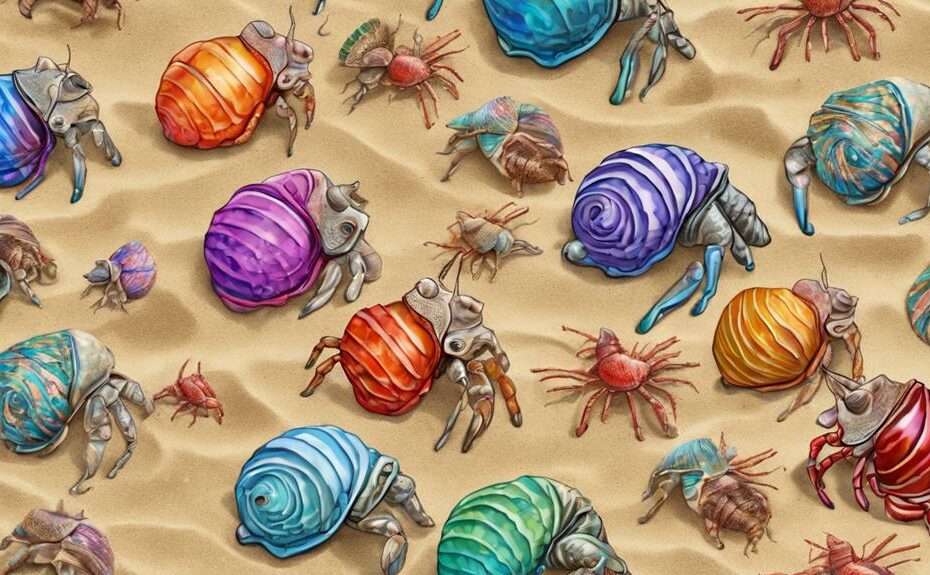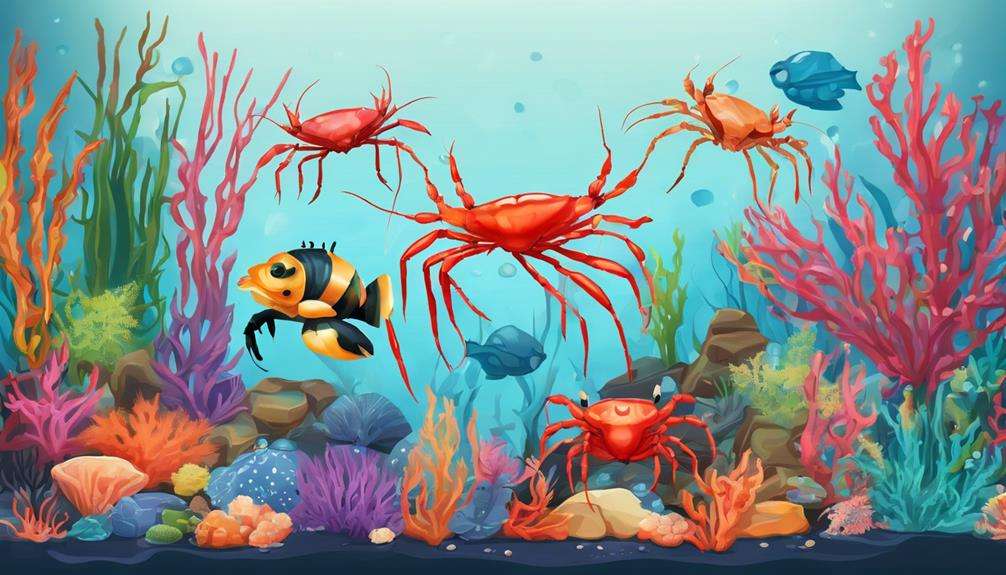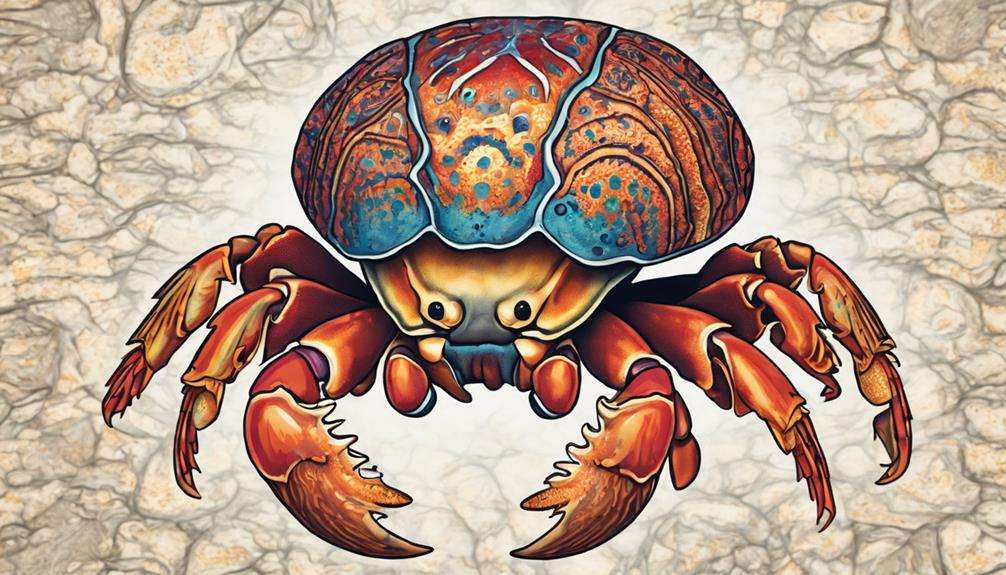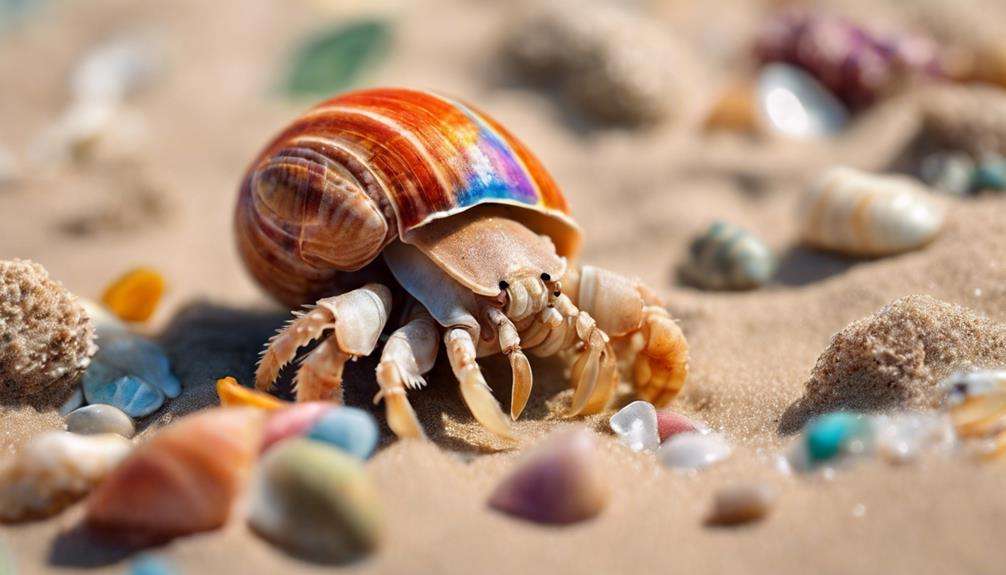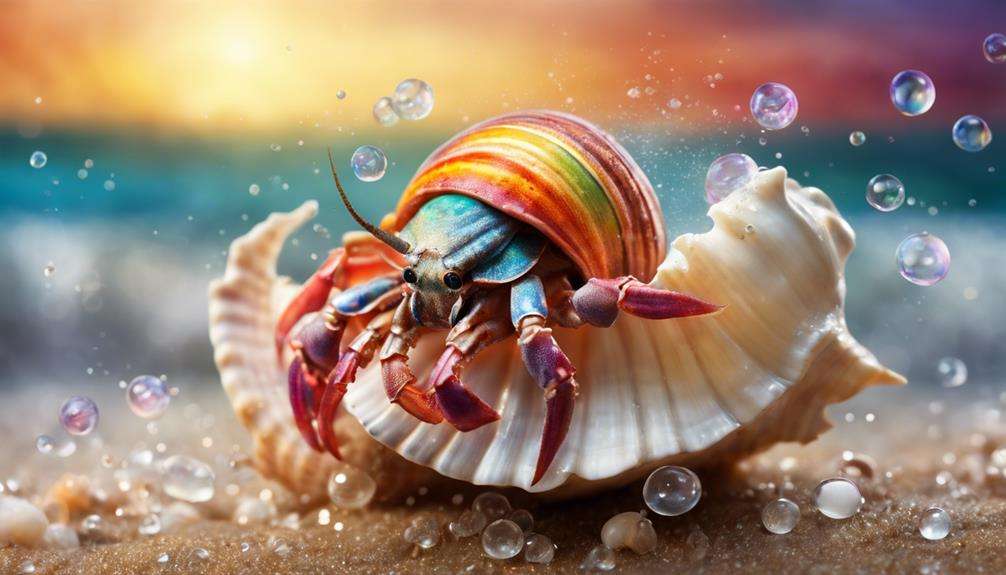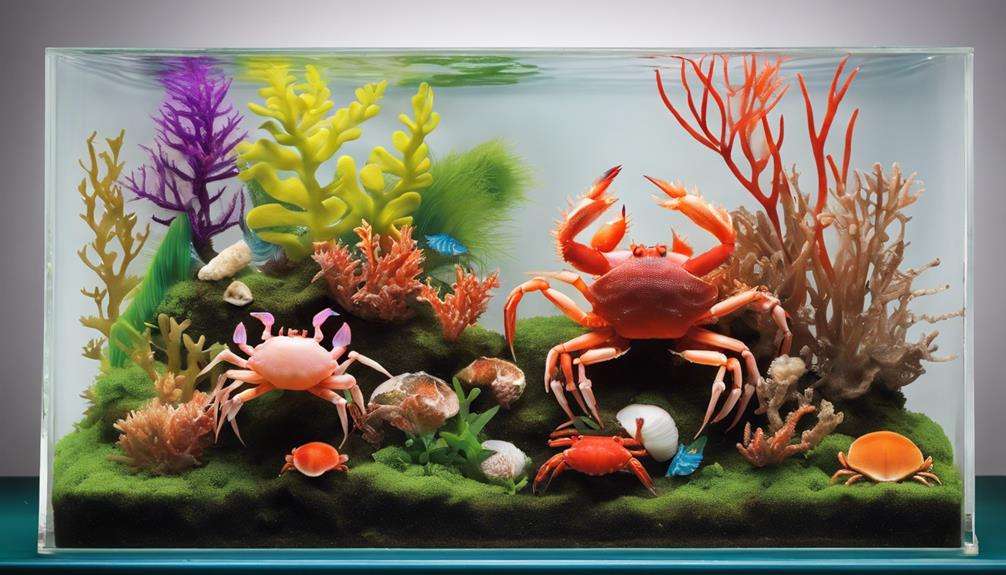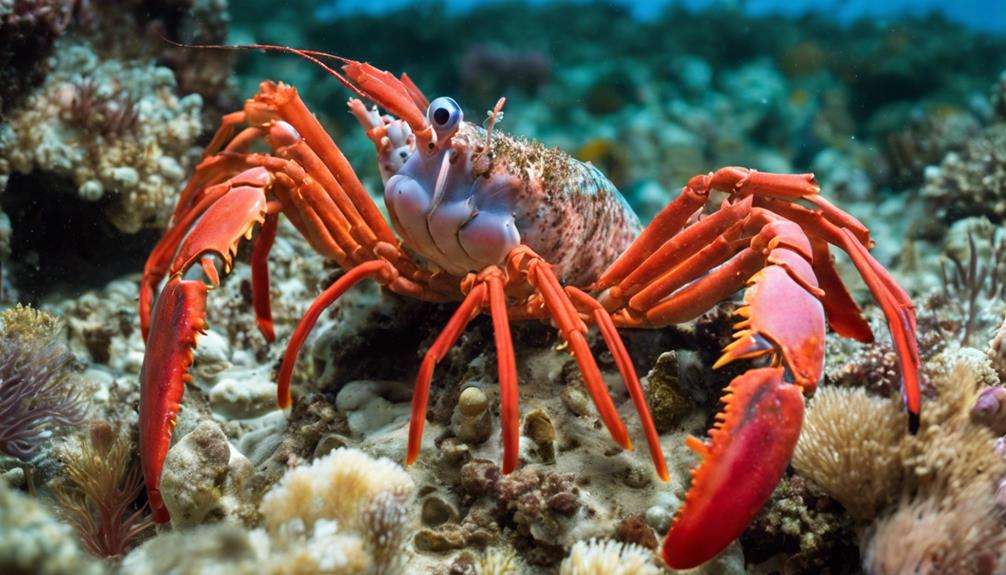Imagine discovering a world beneath the waves where creatures like the Rainbow Lobster and Electric Blue Crayfish roam. These captivating crustaceans not only capture the imagination but also provide a unique window into the mysteries of the ocean.
As you explore the exotic lineup of marine wonders perfect for kids, you'll encounter a diverse array of colors, shapes, and behaviors that promise to spark curiosity and awe.
Who knows what other fascinating secrets these underwater inhabitants hold?
Key Takeaways
- Colorful crustaceans like Rainbow Lobster and Vampire Crab are ideal for kids due to vibrant colors and unique appearances.
- Captivating crab species such as Pom Pom Crab and Red Claw Crab offer captivating behaviors and appearances for children to enjoy.
- Habitat and care tips are crucial, including providing suitable hiding spots, varied diets, and maintaining proper tank conditions.
- Aquatic setup enhancements with Pom Pom Crab and Blue Leg Hermit Crab add vibrant colors and unique touches to aquariums, promoting a balanced environment.
Rainbow Lobster
The Rainbow Lobster, scientifically known as Cherax quadricarinatus, presents a vibrant and captivating freshwater species highly sought after in the aquarium industry for its striking colors and unique characteristics. When it comes to hermit crab care, providing a suitable environment is crucial for the well-being of these colorful crustaceans. Rainbow Lobsters require a tank with plenty of hiding spots like caves or plants to mimic their natural habitat, as they can be shy creatures that appreciate seclusion. Ensuring the water quality is optimal is essential; maintaining proper pH levels and temperature between 75-82°F (24-28°C) is vital for their health.
Feeding Rainbow Lobsters a varied diet is essential for their nutrition. As omnivores, they enjoy a mix of vegetables, algae, insects, and commercial sinking pellets. It's essential to avoid overfeeding to prevent water contamination and obesity. Regular water changes and tank maintenance are necessary to keep the environment clean and conducive to their well-being. By providing a suitable habitat and a balanced diet, you can ensure that your Rainbow Lobster thrives in your aquarium setup.
Electric Blue Crayfish
Originating from Florida, the Electric Blue Crayfish, scientifically referred to as Procambarus alleni, boasts a mesmerizing electric blue hue that captivates aquarium enthusiasts worldwide. These freshwater crustaceans are popular in the aquarium trade for their stunning coloration. Here are some key points about the Electric Blue Crayfish:
- Regeneration Ability: Electric Blue Crayfish are known for their remarkable ability to regenerate lost limbs, a fascinating process to witness in your aquarium.
- Omnivorous Diet: These crayfish are omnivores, enjoying a diet that includes plants, algae, small invertebrates, and commercial sinking pellets to maintain a balanced nutrition.
- Molting Process: Like other crustaceans, Electric Blue Crayfish molt as they grow, shedding their exoskeleton to accommodate their increasing size. During molting, they're vulnerable until their new exoskeleton hardens, so providing hiding spots is crucial for their safety.
Understanding the molting process is essential to ensure the well-being of your Electric Blue Crayfish as they go through this natural growth cycle.
Vampire Crab
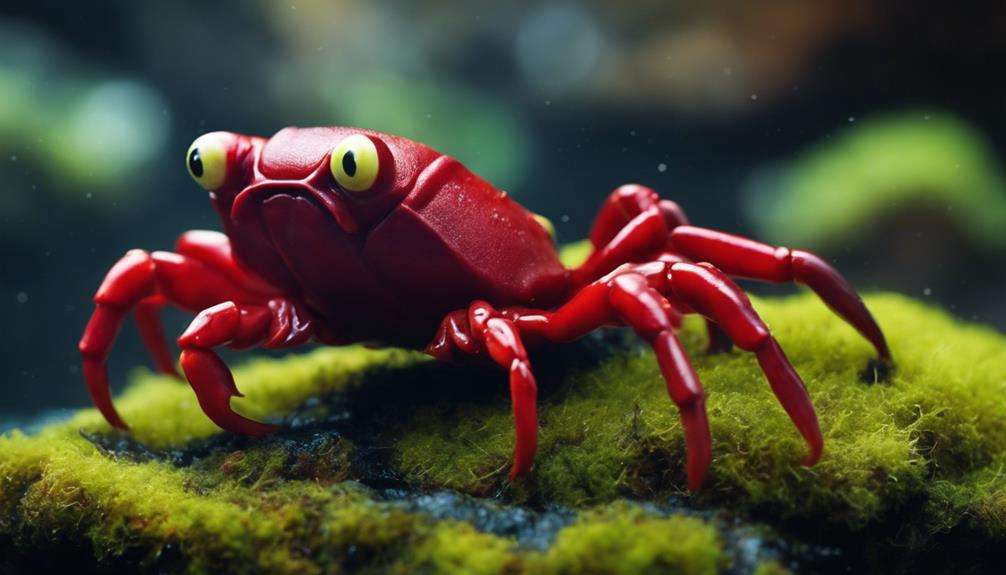
Vampire crabs, named for their dark coloration and unique appearance, are intriguing creatures that make captivating pets for kids.
These small land crabs require a humid environment with freshwater pools for soaking, mimicking their natural habitat in Indonesia.
With their striking colors and interesting behaviors, vampire crabs are an excellent choice for children interested in caring for exotic crustaceans.
Unique Vampire Crab
Native to Southeast Asia, the unique and colorful Geosesarma species, known as Vampire Crabs, exhibit striking red and purple hues reminiscent of vampire lore. These exotic land hermit crabs have captivating characteristics that make them intriguing pets for kids:
- Colorful Appearance: Vampire crabs showcase vibrant red and purple colors on their carapace and legs, adding a pop of color to any tank.
- Humid Habitat: They require a humid environment with access to both land and water, mimicking their natural habitat in the wild.
- Fascinating Behaviors: Vampire crabs are active climbers and burrowers, often engaging in social interactions within their group, making them a delightful spectacle to observe.
Kid-Friendly Care Tips
When caring for Vampire Crabs, ensuring a suitable habitat that meets their specific needs is crucial for their well-being and overall health. These aquatic animals require a humid environment with access to both land and water areas in their tank.
To maintain their vibrant colors and health, provide a varied diet of algae wafers, fish pellets, vegetables, and fruits. Additionally, offering hiding spots and climbing structures is essential for vampire crabs to display natural behaviors and feel secure in their surroundings.
Remember to regularly clean their habitat and monitor water quality to ensure a healthy environment for these unique crustaceans. By following these care tips, you can create a thriving ecosystem for your Vampire Crab.
Thai Micro Crab
The Thai Micro Crab, renowned for its small size and peaceful demeanor, is a captivating freshwater crustacean species native to Thailand. These tiny crabs, also known as Limnopilos naiyanetri, make an excellent addition to freshwater aquariums, especially for beginners.
Here are some key characteristics of the Thai Micro Crab:
- Unique Appearance: Thai Micro Crabs have a distinctive triangular body shape and are typically adorned with reddish-brown coloration, making them stand out in aquariums.
- Algae Eating Abilities: These crabs are efficient algae eaters, contributing to maintaining a clean and balanced aquarium ecosystem by controlling algae growth.
- Ease of Care: Thai Micro Crabs are relatively easy to care for, requiring a well-maintained freshwater aquarium with suitable hiding spots and a varied diet. Their peaceful nature makes them an ideal species to introduce to budding aquatic enthusiasts.
Consider adding these fascinating Thai Micro Crabs to your freshwater aquarium to enjoy their beauty and beneficial behaviors.
Pom Pom Crab
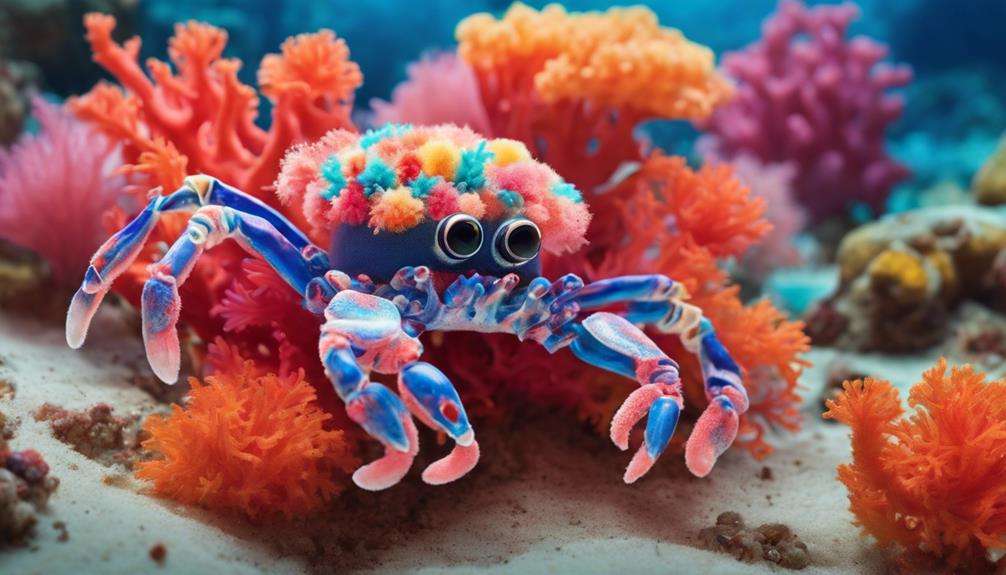
The Pom Pom Crab, scientifically known as the Boxer Crab, showcases a fascinating behavior of carrying sea anemones in its claws. These anemones provide the crab with a unique defense mechanism by using their stinging cells to deter predators effectively.
If you're considering caring for a Pom Pom Crab, it's essential to understand their symbiotic relationship with the sea anemones and the specific care requirements needed to ensure their well-being.
Unique Crab Behavior
In the realm of unique crab behavior, the Pom Pom Crab, scientifically known as Lybia tessellata, stands out for its fascinating symbiotic relationship with sea anemones. These hermit crabs exhibit remarkable behaviors that showcase their adaptive strategies:
- Carrying Sea Anemones: The Pom Pom Crab uses its specialized claws to hold sea anemones, benefiting from the anemones' stinging tentacles for protection.
- Self-Defense Mechanism: When threatened, these crabs wave the sea anemones like pom poms, deterring predators with the threat of being stung.
- Survival Adaptations: Observing these crabs in their natural habitat provides insights into their intricate interactions and the clever ways they've evolved to ensure their survival.
Pom Pom Crab Care
Exploring the optimal care requirements for Pom Pom crabs in a marine aquarium setting involves meticulous attention to tank conditions, feeding schedules, and overall maintenance practices. Pom Pom crabs require a well-established marine aquarium with ample hiding spots, live rock, and a peaceful environment.
Ensure stable water parameters, including temperature (around 75-82°F), salinity (1.023-1.025 sg), and pH levels (8.1-8.4). These crabs are omnivores, so feed them a varied diet consisting of algae, frozen foods, and occasional meaty treats like shrimp or fish.
It's crucial to provide Pom Pom crabs with suitable anemones or soft corals for their symbiotic relationship. Regular monitoring of their behavior and health is essential, ensuring they've space to molt and grow into a new shell.
Kid-Friendly Crustacean Facts
For young marine enthusiasts interested in learning about fascinating crustaceans, the Pom Pom Crab, scientifically known as Lybia tessellata, presents an engaging subject with its unique behavior and symbiotic relationships.
Here are some intriguing facts about the Pom Pom Crab:
- Distinctive Feature: The Pom Pom Crab is named after its behavior of carrying sea anemones in each claw, resembling pom poms.
- Symbiotic Relationship: These crabs use the sea anemones for defense and to catch food, showcasing a remarkable symbiotic relationship between two different types of organisms.
- Habitat: Native to the Indo-Pacific region, Pom Pom Crabs are popular in marine aquariums, making them suitable for kids to observe and learn about different types of symbiotic relationships in nature.
Red Claw Crab
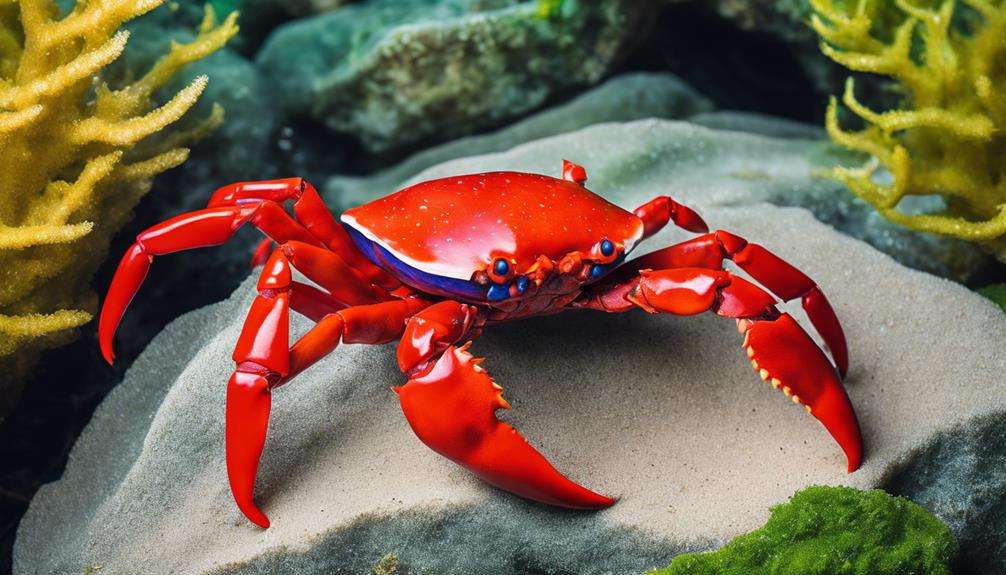
The Red Claw Crab, a captivating freshwater crustacean native to Southeast Asia, is a popular choice for home aquarium enthusiasts around the world due to its striking red claws and intricate shell patterns. Also known as the Thai Micro Crab, these small crabs add a unique touch to aquariums with their vibrant colors.
Red Claw Crabs are omnivorous creatures, feeding on algae, plant matter, small invertebrates, and commercial crab food. To thrive, they require a well-maintained aquarium with hiding spots, access to both land and water areas, and water parameters similar to those of their natural habitat. Despite their relatively peaceful nature, Red Claw Crabs may exhibit territorial behavior, making them more suitable for experienced hobbyists who can provide the proper care.
If you're looking to introduce an eye-catching and engaging crustacean to your aquarium, the Red Claw Crab could be the perfect addition.
Blue Leg Hermit Crab
Blue Leg Hermit Crabs, adorned with distinctive blue legs contrasting their reddish-brown or orange bodies, are sought-after small crustaceans in the aquarium trade for their beneficial scavenging habits. When considering crab care, here are some essential points to keep in mind:
- Habitat: Provide a suitable aquarium with plenty of hiding spots like rocks or artificial caves for the Blue Leg Hermit Crabs to explore and feel secure.
- Diet: Ensure they have a varied diet that includes algae wafers, blanched vegetables, and calcium-rich foods to support their exoskeleton health.
- Water: Maintain both freshwater and saltwater sources in the tank for the hermit crabs to drink and regulate the salinity levels necessary for their survival.
These peaceful crustaceans play a vital role in keeping aquariums clean by consuming algae, detritus, and leftover food. While they can be kept in groups, be mindful of potential shell fights as they may compete for new homes. With the right care and environment, Blue Leg Hermit Crabs can thrive and be a fascinating addition to your aquatic setup.
Frequently Asked Questions
What Is the Best Pet Crab for Kids?
When it comes to Crab Care, the hermit crab stands out as the best choice for kids. Low maintenance, docile, and fascinating to observe, these crustaceans provide an educational and interactive experience for children.
What Are Crustaceans for Kids?
Crustacean crafts are engaging activities for kids, fostering creativity and learning. Understanding crustaceans for kids involves exploring various species, habitats, and behaviors. These creatures, like hermit crabs and freshwater shrimp, offer unique insights into marine life.
Are Crustaceans Good Pets?
Crustacean care involves understanding their needs for feeding, habitat maintenance, and well-being monitoring. Kids can learn responsibility while enjoying interactive pets like hermit crabs. Observing their behaviors offers an educational experience about marine life and ecosystems.
Are Hermit Crabs a Good Pet for Kids?
Hermit crabs make great pets for kids. They require specific habitats to thrive, teaching responsibility. Observing their behaviors and molting process can fascinate kids interested in nature. With proper care, hermit crabs can be a rewarding experience.
Conclusion
In conclusion, these exotic crustaceans offer a fascinating glimpse into the diverse and colorful world of marine life. Their unique adaptations and behaviors provide a captivating learning experience for young explorers.
By studying these creatures, children can gain a deeper appreciation for the beauty and complexity of the ocean ecosystem.
So, next time you encounter one of these amazing crustaceans, remember to marvel at the wonders of nature and the mysteries of the deep sea.
